Application is one of the favorite types of creativity for childrenTo make the lesson as useful as possible, you need to think it through carefully, take into account all possible factors and prepare the necessary material.
The subject matter in different groups may be the same, but the content is necessarily different, corresponding to the child's age. The article examines the features of conducting classes on the topic "Fish in an aquarium" in different groups of a kindergarten: from junior to preparatory.
Benefits of applique classes for child development
Applique is a decorative and applied art technique based on gluing or sewing patterns, figures and other decorative elements onto a background material. The term applique comes from the Latin word applicatio — “attachment” or “application”.
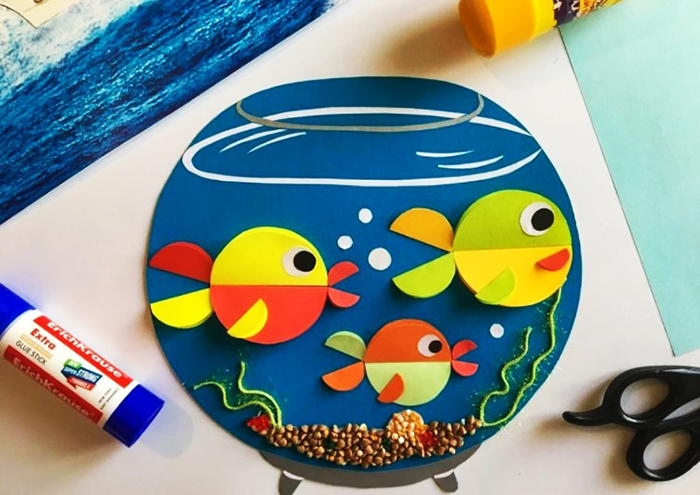
The benefits of this type of creativity for children's development are undeniable:
- by cutting out, as well as laying out and gluing small parts, fine motor skills of the hands are developed, which indirectly influences the development of speech activity (the areas of the brain responsible for both types of activity are located nearby);
- such qualities as perseverance, accuracy and patience are formed; with proper organization of work, the child becomes more independent;
- mental abilities, the ability to analyze, compare, and draw general conclusions are developed: in classes, children become familiar with the concept of the shape of an object, its size, color, compare different details, find similarities and differences, select those details that, according to one or another characteristic, are suitable for modeling a picture;
- reinforce the ability to beautifully arrange an image on a sheet of paper;
- develop the ability to observe safety precautions, maintain correct posture, and maintain order in your workplace;
- creative abilities, imagination, the ability to highlight the main thing and divide the whole into parts are developed;
- learn to create, to make valuable items that can be used as gifts for loved ones or to decorate their room.
Preparing for an applique lesson
To make the lesson as useful and productive as possible, you need to interest the child.
To do this, you should conduct the lesson in the form of a game or a fairy tale:
- The game situation can be presented as a walk in the forest, city, park. Children meet different plants, animals, fairy-tale characters who ask them for help. For example, they saw an aquarium with a sad fish swimming in it. She says that she lives alone in the aquarium and is very bored because she has no one to play with. She asks to make friends for her - the same fish.
- If the child particularly liked a certain fairy tale, then you can do applique work as it is being told: make characters (goldfish) or model a situation (fish swimming in an aquarium, in a pond). You can “create” a fairy tale using the applique technique: make several illustrations: a fish playing, having lunch, sleeping, then combine them into a book. This book can then be “read”.
It is important to think through the topic of the lesson, stages, plot and main character in advance. It is necessary to set a goal for yourself, to achieve which you will focus during the lesson.
While working, it is advisable to talk through all your actions, then it will be easier for the child to understand the logic of the actions.
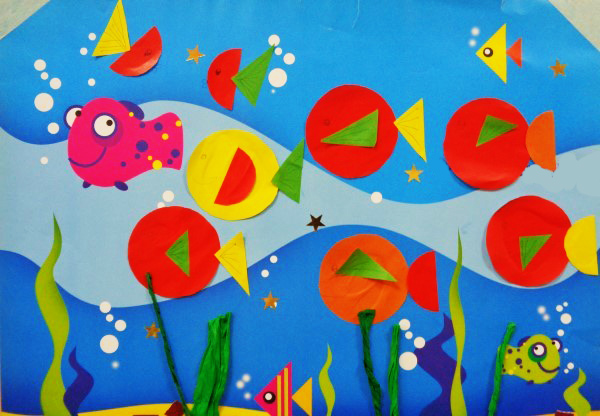
One of the key moments in preparation for the lesson is the organization of the workplace. If you do not pay attention to this issue in advance, then during the lesson you will have to be distracted by insignificant moments that will slow down the work and distract other children.
Therefore, it is necessary to provide that:
- all children had the necessary tools and materials (they must be safe and appropriate for the child's age);
- it was convenient for the pupils to use containers (boxes, plates, trays) for ready-made forms, scraps of paper and ready-made figures;
- the teacher could freely go to any work place if the child needed help.
The prepared material should correspond to the age of the children. In the younger group (3-4 years old), the teachers themselves cut out the details and silhouette images of objects for gluing. In the middle group (4-5 years old), the children are asked to cut out the necessary details themselves from prepared figures of a certain size.
In older groups (up to 7 years old), decorative applique is mainly carried out according to the children’s design, so they need to be provided with a wide choice (figures of different colors and shades).
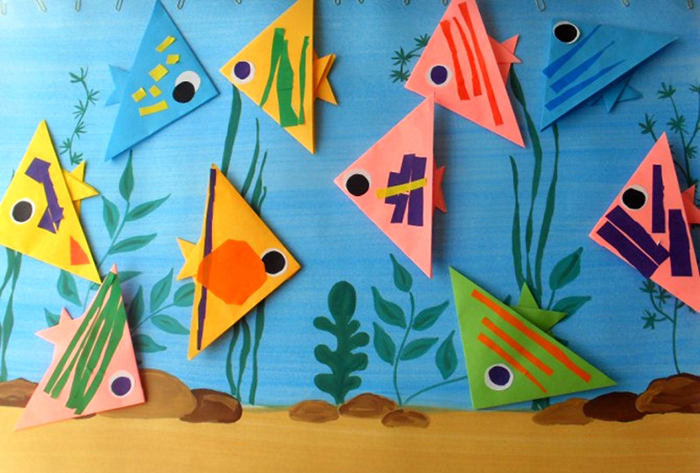
The applique “Fish in an aquarium” (preparatory group, senior, middle or junior) can be framed and decorated with rhinestones, glitter, beads, and small beads.
Step-by-step instructions for making appliques using various techniques
There are 2 techniques for performing applique:
- Traditional. Children make flat images from paper that have no volume.
- Unconventional. Various materials are used for the work: fabric, cereals, small objects (buttons, beads), pasta. The images can be three-dimensional.
Appliques made in any technique can be subject-based (individual images), plot-based (reflecting some event) and decorative (used to decorate objects).
In addition, they are divided into types depending on the volume of the craft (volumetric and flat), color (monochrome and multicolor), the presence of symmetry, and the material used. Each type of work has its own characteristics.
Application using templates
A template is a schematic representation of a future product. It can be drawn or printed. Some people think that the template should only be used with kids, but this is not true. Different groups work with the template differently.
Application "Fish in an aquarium" in the junior group: children lay out the finished silhouette of a fish on cardboard and glue it.
Tear-off applique "Fish in an aquarium" in the senior group:
- Children choose the color themselves and tear the colored paper into small pieces.
- They are glued onto the fish template to completely fill the space.
- Fill the aquarium with algae and paper stones.
- The completed template is glued.

Application "Fish in an aquarium" (preparatory group):
- Children cut out all the details of the future applique (parts of fish, seaweed, stones) from suitable paper using a template (it is applied to the sheet and traced with a simple pencil).
- Place the drawing on a prepared sheet of cardboard (this is an aquarium).
- Glue the parts onto the base.
In older preschool age, you can use cutting out symmetrical silhouettes from paper folded in half. Children independently cut out templates and glue them to the base.
Geometric applique
This type of applique involves creating images from cut paper geometric figures. It is done in all groups, only in the younger and middle groups they mainly make subject images, and in the older groups - more complex, plot-based ones.
The work on the applique “Fish in an aquarium” will depend on the age of the children:
- In the younger group, they make one fish from geometric shapes: an oval and a triangle (body and tail). They draw the eye with a pencil.
- In the middle group, the task is a little more complicated: the children themselves cut out the details from the prepared figures: an oval from a rectangle, triangles from a square. Then they make fish on the base and glue them.
- Older preschoolers cut out all the elements, make fish of different shapes and colors, cut out decorative elements for the aquarium. After that, they lay out the plot on the base and glue all the elements.
Made of fabric
The fabric applique "Fish in an aquarium" can be simple or complex, depending on the number of elements. Basically, such work is done by children of the preparatory group. The details should be stylized, with a clear, correct outline. For work, you can take fabric of any type and color.
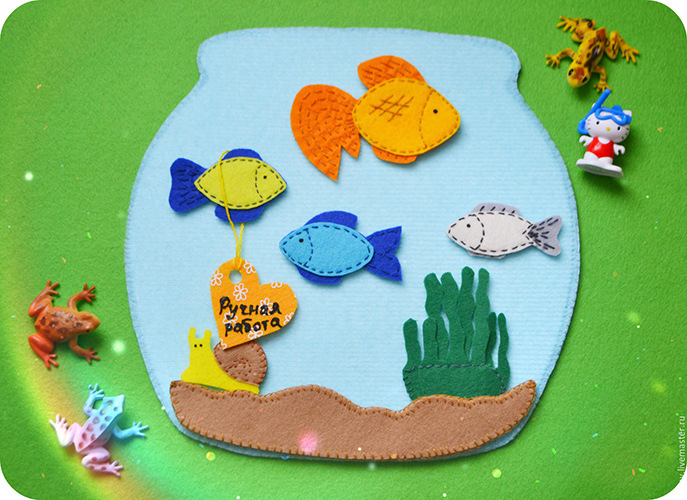
The order of actions when working with fabric:
- Choose a suitable fabric and prepare it for work: starch cotton, wring it out well and iron it with a hot iron, and stretch synthetic fabric, spray it with a gelatin solution and dry it, but do not iron it.
- Cut out the applique pieces.
- Generously coat the back side with glue and glue it to the base.
- To prevent the fabric from shrinking while drying and to ensure better adhesion, cover the craft with a cloth and place a warm iron on top.
Children's work is often fixed to the base with glue, because they cannot hold a needle and handle it carefully. Older preschoolers can cut out details from fabric themselves, while little ones are given a ready-made set of figures, which they then simply glue.
Volumetric applique
The technique of creating three-dimensional crafts is not very different from the technique of making flat images: the parts are glued to the base in the same way. But in this case, either an initially three-dimensional material is used (cotton wool, twisted napkins, plasticine, natural material), or volume is given using various techniques.
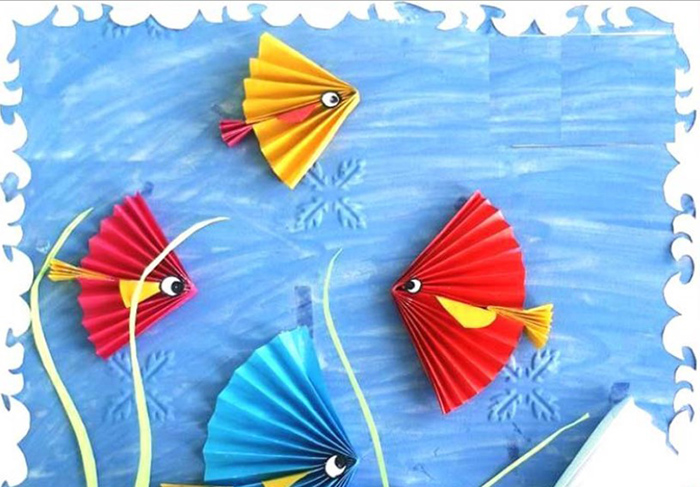
Different techniques will be used in classes for different age groups.
Application "Fish in an aquarium", junior group:
- Children tear the napkin into pieces and roll them into balls.
- Apply glue to the image of a fish on cardboard.
- Glue the balls.
Plasticine picture "Fish" for the middle group:
- Children knead the plasticine to make it soft.
- Place small balls on the image of the fish and smear them to color the entire picture.
- Glue on the eye - a black ball of plasticine.
- Additionally, a stack can be used to draw gills and highlight stripes on the fins and tail.
- You can glue beans or pea halves onto the fish’s body – these will be scales.
For children in the older group, you can prepare only a blue sheet - an aquarium. They make everything else from plasticine themselves (if it is a plasticine applique). Another option: draw a fish, spread glue all over the body and glue different types of cereals, highlighting all the parts.
The application “Fish in an aquarium” (the preparatory group can use different techniques) is performed in the following ways:
- origami (fish are made using the origami technique and glued to the base);
- quilling (decorating painted fish with different elements made from twisted strips);
- end-cutting (the napkin is cut into squares, they are stretched over the end of a brush, coated with glue and glued onto the drawing).
When conducting any activity, it should be remembered that small children are given ready-made templates, older children are asked to cut out elements from shapes of a certain size, and older preschoolers do almost all the work themselves.
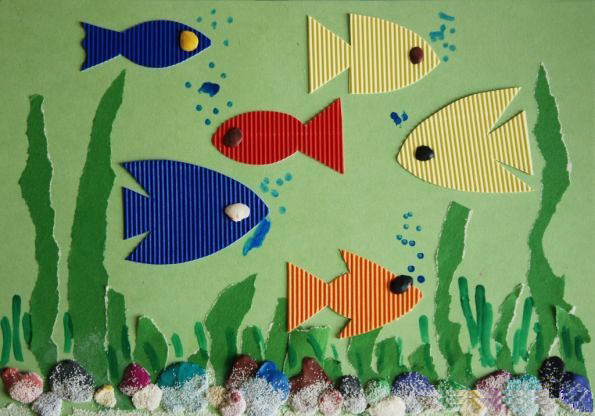
In addition, in the junior and middle groups it is necessary to demonstrate an example of the work being done and a finished sample; in the senior groups it is necessary to demonstrate a sample only if the children do not have the relevant experience.
Card index of applique classes in preschool educational institutions
A card file is a unique way of storing information. It can contain various information: lesson plans, questions and assignments for children on various topics, poems and riddles for the introductory part of the lesson, various games.
After processing, all information is entered onto sheets – cards.
- “Application “Fish in an aquarium”: preparatory group” - this is how you can title a card with a lesson plan.
- "Cereal applique" - this sheet will indicate the types of applique that the child will be able to do while studying this topic.
The following advantages of the card index can be highlighted:
- concentration of necessary information in one place;
- brevity of material, absence of unnecessary information;
- the ability to quickly draw up a group work plan for a certain period, taking into account its individual characteristics and the capabilities of the educator;
- making it easier to write plans (only the card number is entered into the plan).
The card index is very convenient to use: having carefully read the information on the card, the teacher will be able to quickly prepare a summary for one lesson. If desired, you can make a plan for the educational work of the group for a certain period of time with a gradual complication of tasks.
Fish applique ideas for kids
In the process of mastering applique techniques, the child learns to use scissors and hands. All this happens gradually, not immediately. Therefore, you cannot give too difficult work to little ones - they will not cope, and they will lose interest in the subject. All tasks must correspond to the age of the children.
Here are some more applique options for preschoolers.
Junior group:
- Volumetric applique "Goldfish". On the ready template, children make cuts in the tail and fins. The result is a "fluffy" fish.
- A fish made from natural materials: leaves, half a walnut shell with a tail - a leaf.
Senior group:
- Geometric applique "Fish". The body is a circle, the fins, tail and mouth are strips of different lengths, folded in half (the fold is not ironed). The scales are small squares, glued in a chaotic manner.
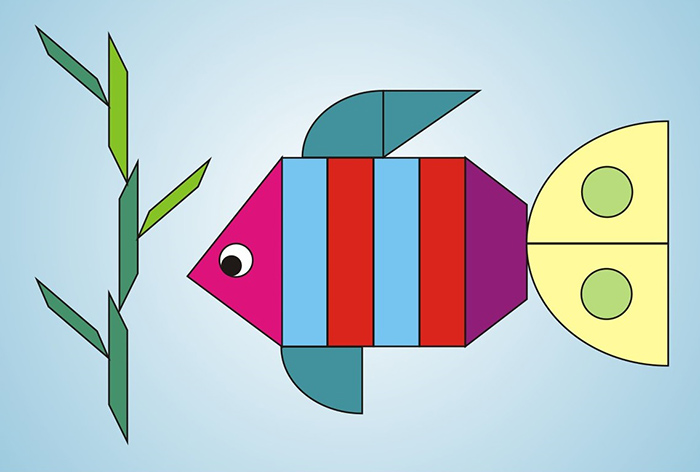
- Fish made from strips of colored paper. On the template, use a stationery knife to make slits at equal distances from each other. Children only need to insert the colored stripes in a checkerboard pattern. The fins can be made from corrugated paper.
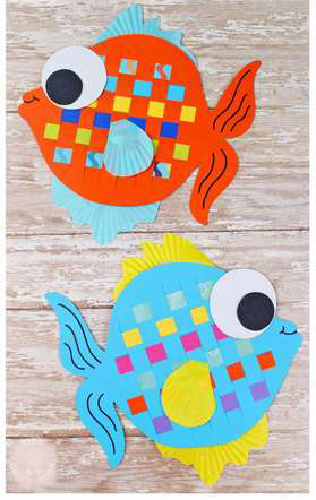
- Fish from a disposable plate. Cut a triangle off the plate and glue it in place of the tail.

- Fish from circles. The body is a circle bent in half. The tail is the same circle with a bent corner.

Preparatory group:
- Symmetrical fish. Fold a sheet of paper in half and cut out half of the fish. Cut out diagonal lines, rectangles, and other shapes inside, and then unfold. You've got an unusual symmetrical fish.
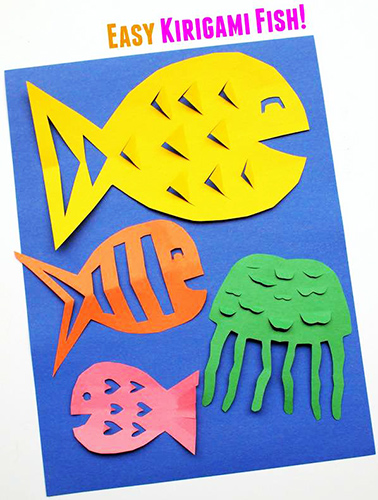
- Application "Fish". Cut out the body from colored cardboard. Cut out small circles, fold them in half and glue them as scales. For the tail and fins, cut out stripes, glue them, curl the ends. Cut out the mouth and eye from colored paper and glue them.


- Fish in origami technique.
Recommendations from psychologists and teachers
It is important to remember that the attitude towards children's creativity should always be positive, because creativity is a constant companion of children's development, as V.V. Davydov, a famous teacher and psychologist, said. There is no need to suppress this desire at the root, because much of what a child can do in his life depends on the development of the child.
The experience gained during applique classes can be used by preschoolers in other activities. After all, in the process of creativity, children learn to plan work, and this is important not only in work, but also in play and educational activities.
Application classes are recommended as a means of expanding children's capabilities and developing their independence. For this purpose, it is recommended to provide assistance in the work only at the request of the preschooler.
If a junior group pupil wants to cut out the details himself (although the program does not provide for this), then he should be given such an opportunity. Even if these fish for an aquarium are suitable for the creativity of pupils of the preparatory group.
Video about the application
Master class on making the applique “Fish in an aquarium” from cotton wool:
